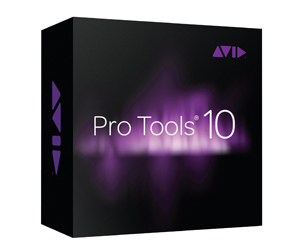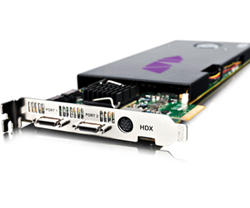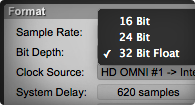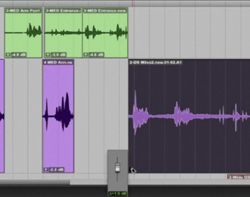Pro Tools 10: Worth It?
Avid surprised many of their users with the recent release of Pro Tools 10. It came not even a full year after the announcement of Pro Tools 9, an update that had brought significantly more power to native systems.
Although version 9 was one of Pro Tools’ most expensive upgrades to date, it was fairly well-received, especially among native users. This group found that Avid had finally made good on some of their most long-standing requests, opening up basic features like auto delay compensation, MP3 bounce options and full-fledged Beat Detective to those without an HD card.
The latest release, Pro Tools 10, continues to close the gap between HD and Native, revamping the underlying system architecture and plug-in protocols to blur the lines between product categories even further.
Like its predecessor, PT 10 is one of the more costly audio releases from Avid. But unlike PT 9, the majority of immediate internet chatter seemed to be disparaging. Those of us in the pro audio field have come to expect a few groans and grumbles whenever the market leader gives studio owners yet another reason to part with more hard-earned cash, but this time, it was more than that.
While the detractors have some valid gripes, there are others who are genuinely excited about the new release. We’ll look at both sides and help you decide whether PT 10 is right for your studio.
HDX – Cost Effective For New Users
There is at least one group that has something to be excited about. Those specking out a new installation, or upgrading to an HD system for the first time, will find the new HDX hardware offers more power and I/O at a lower price point than ever before.
We heard from a few users who told us this was the release that finally made them decide to upgrade their studios from suped-up LE systems to full-fledged HD.
Meanwhile, Uri Djemal of Manhattan’s Madpan Productions said he was convinced to “sidegrade” by moving from an HD2 system to HD Native with Pro Tools 10.
“I was looking at a scenario where my HD2 system would be obsolete after PT 10. The old cards wouldn’t be able to run with the software, or the newly coded plugs. So I took a plunge, trading in my HD 2 Accel system to Pro Tools HD Native which comes with a free upgrade to PT 10. Total cost out of pocket: a bit over $600.”
“Some of the new features are long overdue, but they don’t disappoint. I can’t imagine using another DAW, and the thought makes me want to pull out what hair I have left in my head. Pro Tools, despite its significant change, is just as familiar and intuitive as always.”
Those who decide to opt for dedicated DSP chips will find that HDX affords up to 5x more processing power per card, and allows users to assign specific tasks to either the HD cards or to the RAM cache, potentially freeing up more juice for power-hungry virtual instruments and high-resolution video.
32-Bit Floating Point – An Unexpected Improvement in HD Sound Quality
Price-to-performance ratio aside, Grammy-winning producer/engineer Vaughan Merrick is most excited about floating point architecture finally coming to HD.
“You could easily write an extensive article on the benefits of 32-bit floating point math and how HDX at 192k is a much better sounding system than TDM, which is the part that I really care about. The other various features are nice, but I don’t think the sound quality argument can be undersold.
“I personally stopped using my TDM system when Pro Tools 9 went Native, since the 32-bit floating point system sounds so much better than TDM.”
Merrick is also excited about the ability to work as easily at 24/192 as he might have worked at 24/44.1 in the past. For him, every step away from granularity toward greater transparency is a step in the right direction, but it’s HDX’s embrace of floating point architecture that seals the deal.
“They defended 48-bit fixed-point for years, and even wrote some white papers about the advantages. The TDM system was developed in the late 90s, and I presume fixed point processors were the only way to get low-latency performance at a price-point most of us could swallow. But they’ve embraced 32-bit floating point throughout the system now, which means better sound quality and consistency between DSPs.
“Basically, the 32-bit float system allows the 24-bit word length to be preserved in its entirety the entire time it’s in the box. When you turn down the fader in floating point, you’re not getting any degradation of the signal; there’s just less distortion inherent in the math.”
“It’s a complicated discussion to have,” Merrick tells us, but he maintains that listening tests confirm this will be a welcome change for HD users.
New Features – Powerful, Welcome, But… Underwhelming?
On their own, some of Pro Tools 10’s new features are impressive. “Clip Gain”, which was a centerpiece of Avid’s press junket, is a handy tool for editors seeking more fluid dynamic control. The elimination of fade files in the new engine allows for real-time edits to crossfades, and speeds up session load times dramatically. Eucon control has been improved, and the bundled suite of plug-ins, including the new Channel Strip, is quite nice.
Taken together, the entire tool-set might easily warrant the $600 price tag for new professional-level users. But is it worth a $300 upgrade from PT 9 for users who already spent $300, less than 12 months ago? And what about the $1,000 upgrade cost for HD users?
To be fair to Avid, the sheer amount of work their team put into designing an entirely new engine may be deserving – they did throw away a lot of old code for this new release – but that doesn’t mean an immediate upgrade makes sense for most of their customers.”
Producer/Engineer Allen Farmelo, who’s often quick to embrace significant new updates, is cool-headed in his reasons for skipping this one.
“Aside from a few bugs, Pro Tools really is the best DAW out there for serious record production,” Farmelo says. “And the new Avid I-O converters sound amazing. But I’m just facing the realities of what this current offering means to me and my business.
“I might be one of the worst candidates for a Pro Tools 10 upgrade because I already own an HD system. The $999.00 update cost, plus the dawning reality that my TDM plug-ins will soon be unsupported has me, for the first time ever, holding off on an upgrade.
“I paid five figures for my HD system not that long ago (plus a few upgrades along the way), so to be putting another $1K into a system that will soon require even more software purchases feels wrong for me and my business right now.
“Instead, I’m putting all of my re-invest money into hardware. I keep looking at my Studer A-80, which I use daily, and marveling that it is thirty years old and there have been no format changes: 1/2″ tape, XLR connectors, capacitors – Even the pinch rollers are still built to the same specs. Similarly, when I sit down at my console I know I will be using it for decades. I’ve actually factored the value of my console into my retirement plans. Try that with a digital system!”
He’s definitely not alone. “We recently upgraded to PT 9, so we won’t be upgrading again so soon,” says Matt Werden, engineer for LoHo Recording and Blue Man Group.
“We have 4 HD rigs, plus a couple other software-only rigs, and tons of plug-ins, so it isn’t cheap or easy for us to upgrade. Aside from the cost, the PT 10 release is a bummer for us because PT 9 is still not stable. I was expecting a year or more of CS updates, but now I’m stuck with an older version that no one will be paying attention to.
“Some of the features in PT10 seem great, but it seems they’ve been saving things like clip based gain just so they could justify getting more money out of their customers. The whole situation gets a thumbs down from me.”
“No one is holding a gun to your head.”
Farmelo and Werden are pretty even-keeled about the whole thing, but we can’t say the same for everyone.
Mere moments after we broke the story of Avid’s announcement, some of the comments on our site had already begun to look ugly. The same was true across several pro audio forums, where many users vented their frustrations over the cost of the upgrade, the timing, and fact that Avid had not yet gone as far as creating a 64-bit version of the program. And some users, like Werden, were concerned that Avid decided to move on to a new release before addressing all the compatibility issues of the last one.
“I’m not entirely sure why everyone’s so up in a tizzy about a new version coming out this time, except that we’re in economically difficult times,” says Vaughan Merrick. “Quite frankly, that’s a perfectly good reason to be upset about shelling out more coin, but nobody needs to upgrade unless they want to. Hell, I know people who are still using Pro Tools 7 and 8!”
I instinctively understand the frustrations of users who excitedly upgraded to PT 9 months ago, only to find themselves behind the curve already. But with that said, I’d tend to agree with Merrick here. Although I mostly use Pro Tools 8 and 9 in my everyday sessions, I still have Pro Tools 7 installed on my home machine, and it still works great. To me and many others, each new upgrade is an option, not a requirement. If you want to stay cutting edge, I’ve figured it will always be more effective to show it with your work than with your tools.
“Users may wish to upgrade to 10 when and if they upgrade to HDX, or not at all,” says Merrick. “ I don’t get the big hoopla. Everything digital goes through upgrade cycles. For some reason when it comes to upgrading laptops, it’s not a big deal, but upgrading Pro Tools is cause for hysteria? I dunno. To me, it’s just life in the digital era.”
The Future
Avid announced Pro Tools 10 and HDX just a day before the 131st AES convention. They reserved an elegant conference room in the Jazz at Lincoln Center building, and served the reporters they invited some of the best hors d’oeuvres we’d had in while.
In another age, this was the norm for pro audio companies. But when Avid held a well-appointed press junket this year, it was something different; A reminder that they stand alone in the field in many ways, and a reminder that they plan to keep it that way.
Just one week later, Avid surprised the industry again, this time announcing a round of layoffs in which they shed nearly 200 employees – 10% of their total workforce. In any other economy this may have seemed like an ominous move, but not today. There’s even a fair chance this decade could prove to be a new era for Avid.
While many pro users accuse Apple, the owner of Logic and Final Cut Pro, of fumbling on recent updates, even stripping away features and simplifying their programs, Avid has made it clear that they’re aggressively courting an upscale market, even if that might means alienating some of their “prosumer” users. In their November 20th press conference, the company’s motto and constant refrain was “Avid, committed to the professional.”
As their shifting market strategy comes into focus, Avid is bound to make some friends, and some enemies. The reality is that Pro Tools might not be able to compete with DAWs like GarageBand, Ableton Live, and Reaper when it comes to retaining casual users, and just maybe, it shouldn’t try.
Based on recent moves, that seems to be their take at least. Don’t be surprised if Avid is willing to give up some of their share in one corner of the market if it means they can maintain a firm hold on another.
Justin Colletti is a Brooklyn-based producer/engineer who works with uncommon artists, and a journalist who writes about music and how we make it. Visit him at http://www.justincolletti.com.











Bengt Grønås
December 1, 2011 at 7:03 pm (13 years ago)Make no mistake, I use a well proven PC technology, a good Firewire port, and before I start ProTools, I stop all necessary processes and services, including virusscanners, search systems and such, so I make sure the only running program apart from the OS is ProTools 10. The machine has been tweaked for stability and performance according to any available document explaining BIOS settings, registry keys, and Windows settings possible. The machine acts very fast, pro tools is very responsive, and it worked 100% flawless on Protools 8.x and 9.x. I Can run 168 Wavearts Multidynamics, 114 Elysia mPressor, and 277 DVerbs before I get any errors!
On the other hand, After upgrading to PT10, A lot of new errors occurs under regular runs of the revamped program. Here are some of the new “features” available if you should dare to upgrade from 9 to 10. Here’s my gotcha’s and Caveats:
PT10 does not use the much of the Windows 7 x64 machine resources that are available, it only uses like 3GB of my 12GB RAM. 30% of 8 CPUS (4 cores i7 920 with HT).
I get shitloads of ERRORS RECURRING FREQUENTLY: -9128, -9129, -9092
The problem arises most often when using midi and instrument tracks (Yes, Just ONE!!!!) and the delay compensation.
I got this error message on several occasions after a ProTools10 crash in a NEW PT10 session:
“OMP abort: Initializing libguide.lib, but found libiomp5md.dll already initialized.
This may cause performance degradation and correctness issues.
Set environment variable KMP_DUPLICATE_LIB_OK=TRUE to ignore
this problem and force the program to continue anyway.
Please note that the use of KMP_DUPLICATE_LIB_OK is unsupported
and using it may cause undefined behavior.
For more information, please contact Intel(R) Premier Support.”
Well, I’ve set that well-known windows(7) Environment variable now, but I don’t know if it’ll stick.
I used to have MANY larger sessions, more tracks, more midi instruments, more addins (both 32/64bit, native or 3rd party) loaded in to PT9 sessions without any abruptions. Now, this is almost like going back to ProTools 6/7 on old Windows XP.
Before I upgraded from 9to10 I could for example run 2xOmnisphere, 1xTrillian, 2xAddictive Drums, and 2xXpand2 live together with 50-100 audiotracks, without problems. Now if I try to run just ONE of these, the “resources” meter in ProTools goes maniac! I used to be able to run both IKMultimedia ARC and TRacks3, and Slate Digital FXG on a master track. Now I can only run just ARC or it fails.
When using 3rd party RTAS addins ie. WaveArts TrackPlug, XLN Addictive Drums, Celemony Melodyne, etc. These are using more resources than before (according to the PT resource meter) and that causes Protools to “panic”. The CPU/RAM is 100% IDLE compared to the protools metering/measuring?!?! This is frustrating. I should be able to turn a knob saying: Utilize 12GB RAM, Use 80-120Mbit/sec write/read speed on disk, Use 89% of my Quad Core CPU. It would be nice to see ProTools use some of the available resources on a PC, instead of crash-boom-bang
# Features we didn’t need.. (AVID: Did you actually listen to your users ??)
Disk Cache and Disk Scheduler which allow you to load your session completely into RAM for extremely fast operation is not available on the native/LE version, and therefore you should not upgrade from 9 to 10 because of this performance-Con. This is only for HDx systems, so not a real improvement to ProTools itself!!!
The new Channel strip is an embarassement compared to Wavearts TrackPlug or the green mcDSP’s series… I wouldn’t say useless. But hey, listen..
The new Downmix plugin must be a joke.
Export into NEW session, Cool.
Yeah OK, I get the point.
The new DelayMod III, sounds awful. Remove.
AAX vs RTAS? Well, probably better for some plugin developers, no performance proof has been posted anywhere, if you’ve seen one, please give us a hint.
Avid says AAX plug-in format sets the way to 64-bit, but performance on Windows 7 x64 remains to be proven It’s not there, it does not use the PC resources well. Lag, clips, cuts, noises…
Export directly to SoundCloud. Well, that’s not my primary publishing channel, and professionals does not use this. It’s just something we do not need. Soundcloud might be fine for amateurs. If you really want to impress, let us publish to FTP, Spotify, WIMP,
Real Time Fades. Well, diskspace isn’t excactly the largest problem, so we were ok with the fades as they were. Did anything improve (ie. performance). No.
Clip Gain. Imortant feature? Nothing I’ve missed.
32bit floating . Yeah OK, I get the point.
Interleaved,
Yeah OK, I get the point.
AAX = support fro 64bit plugins. Well. How many AAX plugins will there be released before summer 2012?
So, NO is the answer. This is a version 1.0 as far as I can see. When it comes to performance and stability, there is nothing new, and the software is buggy as-is, so better wait for a couple of servicepacks before you enter the world of unknown studio-horror.
Vaughanmerrick
December 2, 2011 at 2:01 am (13 years ago)Couple of points to make. Your issues with 10 dually noted.
Disk Cache and Real Time Fades are of primary benefit to post and film users. The film guys I know really love this feature. As a music guy I am generally agnostic about both.
AAX allows developers to port a plugin that essentially is compatible sonicly whether DSP (HDX) or Native (CPU)
As to Soundcloud, I used to be in agreement about this not being a deliverable format until I had to upload mixes for one of the biggest acts of the last 30 years for band approval, label receipt and mastering purposes. Go figure! So much for the “just for amateurs” prejudice.
Channelstrip is a port of the Euphonix System 5 channel which is very popular in film and post; opinions abound.
Allen Farmelo
December 2, 2011 at 2:25 pm (13 years ago)Just seconding Vaughan’s take on SoundCloud. I now use it as my primary transfer site, and artists, managers and labels all love it. To go straight out of PT to SC will streamline posting mixes for me in a big way. SoundCloud is also nicely tied into Gobbler, which I’ve started using very recently for large file transfers.
Woolie
December 1, 2011 at 9:48 pm (13 years ago)I believe there is a factual error at the end of the article. “While many pro users accuse Apple of fumbling on recent updates for Logic and Final Cut Pro”. Apple did indeed screw the pooch in regards to Final Cut Pro, but Logic has as of this writing not been neutered yet.
Justin Colletti
December 1, 2011 at 10:07 pm (13 years ago)Thanks for weighing in, Woolie. That’s a valid distinction. I agree that was sloppy word choice on our part, and we’ll adjust that sentence accordingly.
It’s Apple’s recent updates to FCP, as well as statements that they may discontinue the Mac Pro line that has some professional users nervous about the direction of the company and the future of Logic.
At this time there haven’t been concerns over a recent Logic update, only Avid’s competitor Final Cut Pro, and we’ll adjust the sentence to make that more clear.
BilboBaggins
December 2, 2011 at 1:03 am (13 years ago)If you just bought a new iMac with Lion non-optional, so you upgraded to PT 9 for $249+iLok, which has show-stopping bugs under Lion, then mere months later Avid announces PT10 for another $299 without having even made PT9 Lion-compatible yet… wouldn’t you be just a little bit pissed off? I’ve had it with Avid. PT9 is end-of-the-line for me.
Anonymous
December 2, 2011 at 8:51 pm (13 years ago)Pro Tools 9.0.6 is now available with official qualification for Mac OS X Lion as well as many stability improvements for Snow Leopard and Windows 7. Free download for owners of Pro Tools 9.0 and Pro Tools HD 9.0. http://bit.ly/ProTools906
BilboBaggins
December 2, 2011 at 9:28 pm (13 years ago)Thanks for the heads up, Tony! That is awesome. Makes me feel MUCH better about my v9 upgrade. I still think that’s the last one, for me, but credit to Avid where it’s due for not leaving me stranded (assuming it solves my main bugs).
Frank Filipetti
December 2, 2011 at 9:33 pm (13 years ago)Hi Justin,
I sent this to David, thinking he wrote it…my bad. Anyway, here are my thoughts from someone who’s lived in both worlds…
I think all the people that are complaining about the cost of PT 10 (or any other upgrade) are the same people who think music should be free for all. There’s tremendous work being done by the people at Avid, Steinberg, Sonar, etc. The stuff just keeps getting better and better for a fraction of the cost of the upgrades of yesteryear. I remember when Sony came out with their 24 bit upgrade to the 16 bit 3348…IT WAS $250,000!!!! When Synclavier upgraded from monophonic to polyphonic, the upgrade was $150,000!!!!
Come on folks. Give these guys their due. This is incredible stuff. And it doesn’t come cheaply. Many of you out there have no idea how lucky we are.
f2
BilboBaggins
December 2, 2011 at 9:43 pm (13 years ago)Your point might make sense if PTHD were the only system and big studios were the only customers. Hint: it’s not and they aren’t.
Eric Jean
February 16, 2012 at 3:36 pm (13 years ago)You must be kidding…I’m a long-time pro tools user, but Reaper looks more and more attractive due to the ridiculous price of these upgrades!
Pro Fools
August 3, 2013 at 11:49 am (11 years ago)How lucky we are? Pro Fools seems to be the only DAW playing catch up with the other, inexpensive DAWS…like Presonus Studio One…and others that have had 64 bit for a few years now.
Pro Fools
August 3, 2013 at 11:53 am (11 years ago)you must be a Pro Fools fan boy?! Try out Presonus Studio One and I personally guarantee you won’t turn back.
Allen Farmelo
December 3, 2011 at 2:06 pm (13 years ago)Reading this piece again, I’m realizing that in the context of the article it’s maybe not entirely clear that I’m not upgrading *right now*. I hope it’s clear that I’m only “holding off on an upgrade,” and not a member of any camp here.
In order to upgrade wisely I’ve got a lot to consider because PT10 is such a paradigm shift. I need to consider what Apple does, whether to keep my converters and go Native or move to the Avid I/O and get HDX, whether companies like Lynx will port for HDX, what cross grade offers exist when I’m ready, and more. And the timing will have more to do with the moment when 32-bit float mix projects start rolling in regularly, and whether I’m able to track in 32-bit at the studios I use for tracking (this could be a while, not sure).
Because of all this, this is just the first time I haven’t been an early adopter of a software upgrade because of the price tag for PT10HD, which won’t solve anything in particular for me right now.
My point about hardware purchases is that they’re much simpler investments that don’t require much strategic thinking, and I’m always clear on those decisions. And I really do marvel at the stability of analog formats over decades when I consider how many digital systems I’ll have owned and discarded over the course of my career.
Vaughan Merrick
December 5, 2011 at 8:40 pm (13 years ago)Allen, just FYI, whether the studios you work at are capable of recording 32 float is irrelevant. The 32 float only applies to the audio once it’s in the computer. In fact, you can retain your projects as 24 bit even though Native and HDX are 32 bit float as long as you don’t convert those files physically to disk as 32 bit float. The system adds the bottom eight bits as an exponent in the program and not necessarily the audio file to disk unless you instruct it to. To be clear, 32 bit floating point does not describe the conversion process at the analog to digital converter.
Your other points are well taken.
John Lee
September 21, 2012 at 6:12 pm (12 years ago)Several of our college Macs now reboot with no audio in PT10, we must manually drag L/R in Setup –> I/O. Many features in my other video editors fail to work after failing to install AMC, no matter how many uninstalls and reinstalls. I use these “consumer” Avid video editors (Pinnacle Studio) and prosumer (Avid Liquid) to produce my public access TV show, along with Magix Music Maker that has 99% of the audio edit/compose features of Pro Tools at a $15 price on Amazon (and some features PT lacks like video effects and 64bit). If I wasn’t trying to get a job at local (bankrupt) TV studios (begging for billion$ in govt welfare), I wouldn’t need Avid products, but our professors agree “there’s no jobs available and none of you will ever get a job in video editing…”
Bengt Grønås
January 1, 2013 at 11:58 pm (12 years ago)it’s just too unstable on any platform.
protools rip u off
June 14, 2013 at 8:06 pm (11 years ago)As a Ex- protools user i have to say im very frustrated and un satisfied customer after spending more than 700 euros on them.
pro tools has the worst audio core manager,where u can even use quick time.
support is lame. and u just go around in circle on the web page
if you are using mount lion forget about your protools 8 versions.
I will never buy again from them. or recomend any of their products.